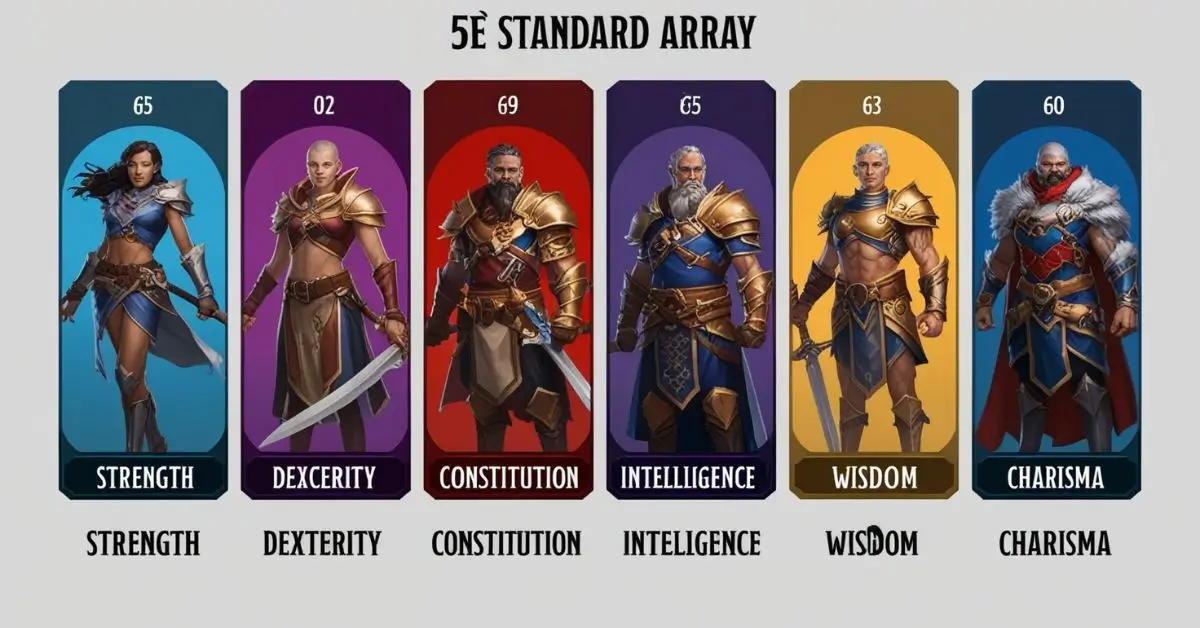Dungeons & Dragons (D&D) has stood the test of time as one of the most beloved role-playing games (RPGs) worldwide. Its enduring popularity is driven by its dynamic mechanics, immersive storytelling, and the creative freedom it offers players. One of the core elements of D&D is character creation, where players define the abilities, skills, and traits of the characters they will control throughout the game.
In the 5th Edition (5e) of D&D, character creation is more streamlined and accessible than ever before, with a variety of methods to determine a character’s ability scores. Among the most popular is the Standard Array, a balanced and structured way to assign ability scores that ensures fairness and consistency across players. In this article, we will dive deep into the 5e Standard Array, discussing its mechanics, benefits, and comparisons to other methods, and how it impacts character creation.
What Is the 5e Standard Array?
The 5e Standard Array is a set of predetermined ability scores that players can assign to their characters’ six core abilities: Strength, Dexterity, Constitution, Intelligence, Wisdom, and Charisma. The scores in the Standard Array are:
15, 14, 13, 12, 10, and 8
Players can assign these values in any order they choose, allowing for flexibility in creating characters that fit their vision while ensuring a balanced foundation. For instance, a player building a strong and resilient fighter might assign the highest values to Strength and Constitution, while a cunning rogue might prioritize Dexterity and Intelligence.
Why Use the Standard Array?
The Standard Array is one of the methods introduced to make character creation more accessible, balanced, and fair. It eliminates the randomness associated with rolling for ability scores and ensures that all players start on relatively equal footing. Additionally, it reduces the likelihood of power imbalances within a party, where one player might end up with significantly higher scores than others due to lucky dice rolls.
The Standard Array is particularly useful in organized play, such as Adventurers League, where fairness and consistency are prioritized.
Breaking Down the Ability Scores
To fully understand the implications of using the Standard Array, it’s important to grasp how ability scores influence gameplay. Each of the six ability scores affects different aspects of a character’s abilities, both in and out of combat. Here’s a brief overview:
- Strength (STR): This score determines a character’s physical power. It affects melee attacks, how much they can carry, and how effective they are in athletic feats like climbing, swimming, or breaking objects.
- Dexterity (DEX): Dexterity measures agility, balance, and reflexes. It influences ranged attacks, armor class (AC), initiative in combat, and skills such as Acrobatics and Stealth.
- Constitution (CON): Constitution represents a character’s physical endurance and resilience. It directly affects a character’s hit points (HP) and how well they can resist fatigue, illness, or poison.
- Intelligence (INT): Intelligence covers analytical thinking, memory, and reasoning. It influences skills like Arcana, History, and Investigation and is a key stat for certain spellcasters, like wizards.
- Wisdom (WIS): Wisdom reflects a character’s perception, insight, and intuition. It governs skills such as Perception, Insight, and Medicine, and is crucial for clerics, druids, and rangers.
- Charisma (CHA): Charisma represents force of personality, charm, and leadership. It affects social interactions, persuasion, deception, and the abilities of bards, paladins, sorcerers, and warlocks.
How the Standard Array Impacts Gameplay
By assigning specific values from the Standard Array, players can create characters that are both capable and well-rounded. A balanced array means that no character will have extreme advantages or disadvantages, which can contribute to a more cohesive party dynamic.
For example:
- A player who wants to create a strong and sturdy fighter might assign the 15 to Strength, 14 to Constitution, and 13 to Dexterity, ensuring they are formidable in combat and able to withstand damage.
- A rogue might prioritize Dexterity, assigning the 15 there, followed by Intelligence or Charisma depending on whether they lean more toward being a clever schemer or a silver-tongued negotiator.
- A cleric might choose to assign the highest value to Wisdom, followed by Constitution, to ensure they are perceptive and able to survive in the heat of battle.
Comparisons to Other Methods of Determining Ability Scores
The Standard Array is not the only method available in D&D 5e for determining ability scores. The Point Buy system and rolling for stats are two other popular methods, each with its own advantages and drawbacks.
1. Rolling for Stats
In this method, players roll 4d6 (four six-sided dice), drop the lowest roll, and sum the remaining three dice. They do this six times and assign the resulting values to their ability scores.
- Pros: Rolling for stats introduces an element of randomness and excitement. It can lead to characters with unique strengths and weaknesses, and there’s always the possibility of rolling exceptionally high scores.
- Cons: Rolling can also result in low scores, which may create disparities between players. One player might end up with several high scores, while another is stuck with mediocre or low ones, potentially leading to frustration.
2. Point Buy System
The Point Buy system gives players a pool of points (usually 27) that they can use to “purchase” ability scores. Each score has a different cost, and players can’t spend more than a certain amount on any single score. The starting value for each ability is typically 8, and players can increase this value by spending points.
- Pros: Point Buy allows for customization and strategic planning. Players have control over how strong or weak their character is in different areas, making it a great option for players who want more agency in character creation.
- Cons: Point Buy can be complex for beginners, as it requires a clear understanding of the mechanics and potential trade-offs. Additionally, while it allows for customization, it can lead to min-maxing (the practice of optimizing a character’s strengths while minimizing weaknesses), which can lead to imbalanced characters.
3. Standard Array
- Pros: The Standard Array is straightforward and easy to use, making it ideal for beginners or players who prefer a simpler approach to character creation. It ensures balance and fairness across the party, and avoids the risk of wildly high or low rolls. The array also offers enough flexibility for most character concepts.
- Cons: Some players may feel constrained by the fixed nature of the array, as they can’t go beyond the limits set by the pre-defined scores. It lacks the excitement of rolling or the full customization of Point Buy.
Standard Array and Race/Class Bonuses
In D&D 5e, many races and classes offer ability score bonuses that can further modify a character’s stats. For example, an elf might receive a +2 bonus to Dexterity, while a dwarf might receive a +2 to Constitution. These bonuses are applied after assigning scores from the Standard Array.
This means that while the Standard Array provides a balanced foundation, racial bonuses can help players optimize their characters even further. For instance, a player who assigns the 15 from the Standard Array to Dexterity for their elf rogue will end up with a Dexterity score of 17 after the racial bonus is applied, making them particularly nimble and effective in combat.
Example of Character Creation Using the Standard Array
Let’s walk through an example of character creation using the Standard Array. We’ll create a human paladin, a character focused on combat and healing.
- Strength (15): As a paladin, Strength is crucial for dealing melee damage. Assigning the highest value here ensures the character will hit hard in combat.
- Constitution (14): A higher Constitution score provides more hit points, helping the paladin survive longer in battles.
- Charisma (13): Paladins rely on Charisma for their spellcasting and certain class abilities, so this score is moderately high.
- Wisdom (12): Wisdom helps with perception and some spells, making it a useful secondary stat.
- Dexterity (10): While not a primary stat for the paladin, a neutral Dexterity score ensures that the character isn’t too vulnerable to ranged attacks or traps.
- Intelligence (8): As a martial character, Intelligence isn’t as important, so this score can afford to be the lowest.
With these values, the human paladin would be a formidable fighter with strong melee abilities, solid hit points, and decent spellcasting potential.
Conclusion
The 5e Standard Array is a valuable tool for character creation in Dungeons & Dragons 5th Edition. It provides a balanced, straightforward method for determining ability scores, making it ideal for both beginners and experienced players alike. By eliminating the randomness of rolling and the complexity of Point Buy, the Standard Array ensures that all players can create capable characters without the risk of imbalances.
While it may lack the excitement of rolling for stats or the customization of Point Buy, the Standard Array offers enough flexibility to accommodate a wide range of character concepts. Whether you’re building a mighty warrior, a cunning rogue, or a wise spellcaster, the Standard Array gives you the foundation to bring your vision to life.
Ultimately, the best method for determining ability scores depends on your personal preferences and the type of game you want to play. But for those seeking a balanced, fair, and accessible approach, the Standard Array is an excellent choice.











